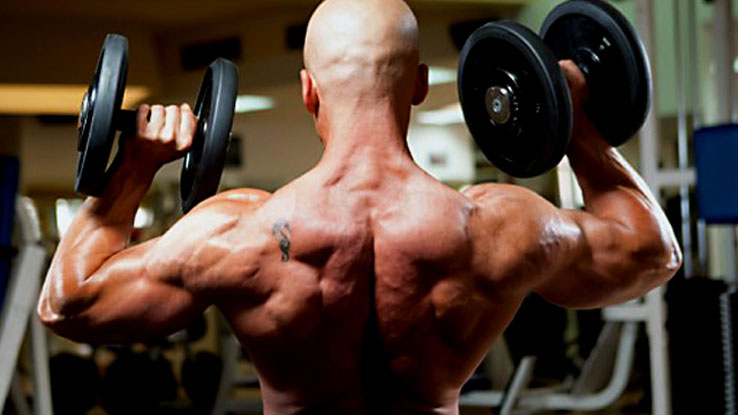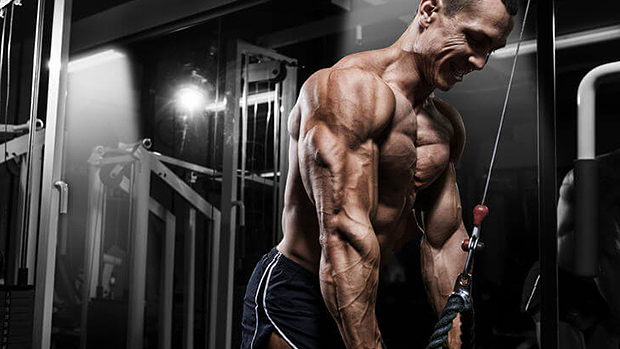Here's what you need to know...
- A smart overhead press allows more ROM, less counterstrain, and restricts cheating far more than a horizontal press.
- Some people aren't genetically cut out to do heavy bench presses.
- Dumbbell pressing beats barbell pressing.
- Avoid bench dips and stick to parallel bars.
Putting thought into your exercise selection, technique, and training volume can make a big difference between training for the long term or the short term.
To steer you down the right path, here are five truths about pressing movements.
1 – Overhead Pressing is More Important Than Horizontal Pressing
Lying flat on a bench with full back support can allow you to move big weight, but the amount of things it does for the actual health of your muscles and joints pales in comparison to anything done overhead.
As long as you don't have any injuries or conditions, the benefits for the shoulder joint and girdle – along with the trunk – are huge, and trump the bench press or push up. Here's why:
- Overhead pressing brings the shoulder into about 50 percent more ROM than horizontal pressing, when done correctly.
- There's less counterstrain on joints since all muscles surrounding the shoulder have more involvement than they would when lying flat.
- There's no cheating in the strict press. When you add that to the big ROM, you get plenty of abdominal and lower back activation for stability purposes.
Take-Home Point: Instead of making Mondays an ever-refreshing episode of the International Bench Press Classic, try some standing presses or push presses instead. To help improve your posture, shoulder health, and core activation, they're sure-fire exercises that also double as serious mass and strength builders.
2 – All Shoulders Are NOT Created Equal
We're all different, and certain movements can have varied side effects for certain populations.
When you look deep and investigate the skeletal breakdown of the shoulder girdle, you'll realize there are three major types of acromion processes on the scapula (see the picture below).
The first type is flat and creates plenty of subacromial space, meaning your chances for getting an impingement injury from pressing are low. Type 2 highlights a curved acromion, which begins to protrude and hang over the ball of the shoulder more than usual, therefore creating less subacromial space and a higher risk for impingement and abrasions to muscle and bursae.
The third type is referred to as a "beaked" acromion – it basically makes pressing an issue regardless of technique or muscular strength as there's minimal space to play around with unless you're on a quest to make your doctor a millionaire.

Take-Home Point: It's true – there are some of us who just may not be cut out for tons of pressing work. It could be worse – certain back injuries or genetic deficiencies (like fusion of vertebral discs) can bar lifters from doing much of anything. If you think you fit into the shoulder impingement zone, give pressing a break and focus on more pulling. Be sure to soft-tissue (foam roll, etc.) the crap out of your shoulders and chest and use dumbbells any time you have to press.
3 – "Locking up the Scapulae" Isn't Always a Good Thing
This is controversial since we're always taught to "set the shoulders down and back" when performing any pressing movement, but now is as good a time as any to show why no movement at the shoulder blade isn't always a good thing.
Apologies, but I need to get my geek on for a bit and give you a short, painless introduction to scapulohumeral "rhythm."
In a nutshell, there's a certain "synchronization" that the scapula and the upper arm have to be in to create a healthy working shoulder joint.
As the upper arm moves away from the body (especially after the first 30 degrees of abduction), the scapula has to upwardly rotate, elevate, and/or protract to varying amounts in order to properly facilitate the movement at hand.
Pinning the scapulae to a bench to do a horizontal push with weights may be a good way to isolate the chest, but at the same time it removes this rhythm from being able to freely occur, which does nothing but contribute to a reason why the bench press and its variations are slightly overrated upper body exercise choices.
Forces applied on joints that aren't in an ideal position may make for a strong effort in the short term, but after a while of constant practice and overuse, damage will be done, which can lead to injury.
Ask any serious powerlifter (I'm talking 600-plus bencher) how much prep work their shoulders need for their push efforts and you'll get my drift. This is why exercises using suspension or old-school bodyweight push ups are what I consider timeless classics.
They encourage proper shoulder mobility and allow synergistic muscles to play their role in moving the scapulae.
Take-Home Point: Horizontal pressing forces you to pin your scapulae in a fixed position, which impedes free movement and risks injuring the shoulder joint.
4 – Dumbbell Pressing Trumps Barbell Pressing
Whether it's a floor press, flat bench, incline, standing press, Z press, or anything I've left out, having integrity at the elbow joint makes for a much more user-friendly pattern.
We all know the surface stuff – dumbbell pressing is cool because it encourages more stability at the shoulder and makes each side "pull its own weight," so to speak.
But all that aside, the ability to play with the elbow in turn affects the position the shoulder is in at the time we press. It would be a wise move – especially if you fall into an acromion category discussed above – to slip into a grip (using dumbbells) that's closer to neutral when performing your dumbbell bench and overhead pressing.
This way the shoulder can roll back farther behind the clavicle where it belongs and save you from unwanted joint pain. The bar path isn't fixed either. Finishing with a narrower grip while neutral can also encourage more arm activation, especially depending on the kind of press you're doing.
Needless to say, if I were to choose one kind of pressing for life, I'd be on board with dumbbell pressing.
Take-Home Point: Dumbbell pressing beats barbell pressing.
5 – Bench Dips Suck
I've talked about this one, and I can't state enough how important it is. Dips are definitely considered a "pressing" exercise by the bodybuilding stock.
Straight up: If you're going to do dips, ditch the bench and use parallel bars.
I don't care how "healthy" your shoulders are – they'll become LESS healthy as a result of bearing tons of load with your shoulders almost completely internally rotated.
That's mayhem for joints and a silver platter request for chronic pain and injury.
Think about a flat barbell bench press once again – people already complain about shoulder issues and the contraindications that the bench press presents as a result. Now think about starting your range of motion in the bottom position (shoulder-wise) of your bench press. That's essentially what you're doing with bench dips.
Take-Home Point: Add a force angle that's more directly in line with gravity and we've got a potion for commotion. Wise up and use parallel bars.
Hot Off the Press
If you're a guy who's been experiencing pain while pressing, I'd put a few of these tweaks to practice and you just might notice your pain start to dissipate.
And hey, if you've realized that your limitations will keep you from ever benching 350, I say so what? If it was up to me, I'd take the healthy shoulders and developed chest muscles – thanks to smarter training – any day of the week.




